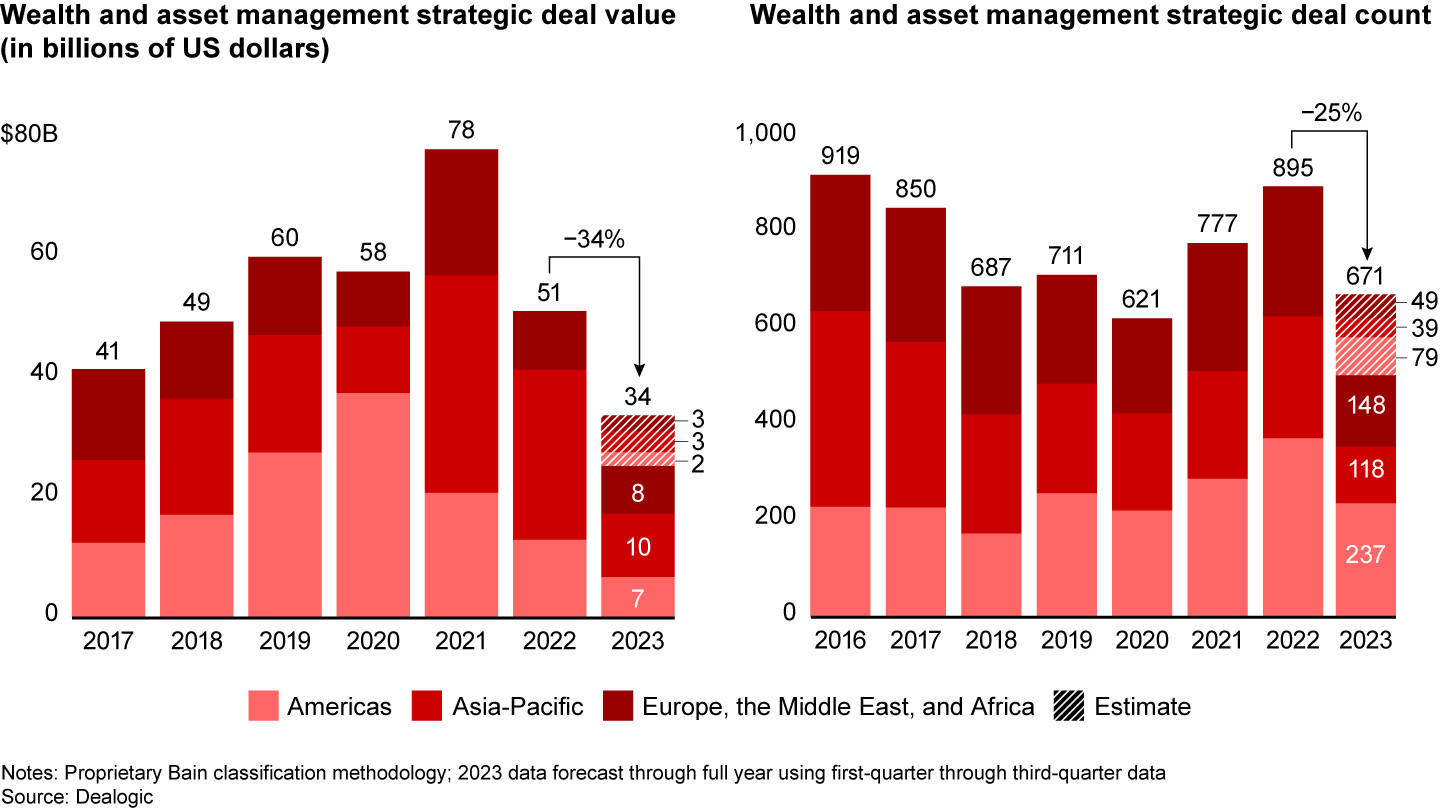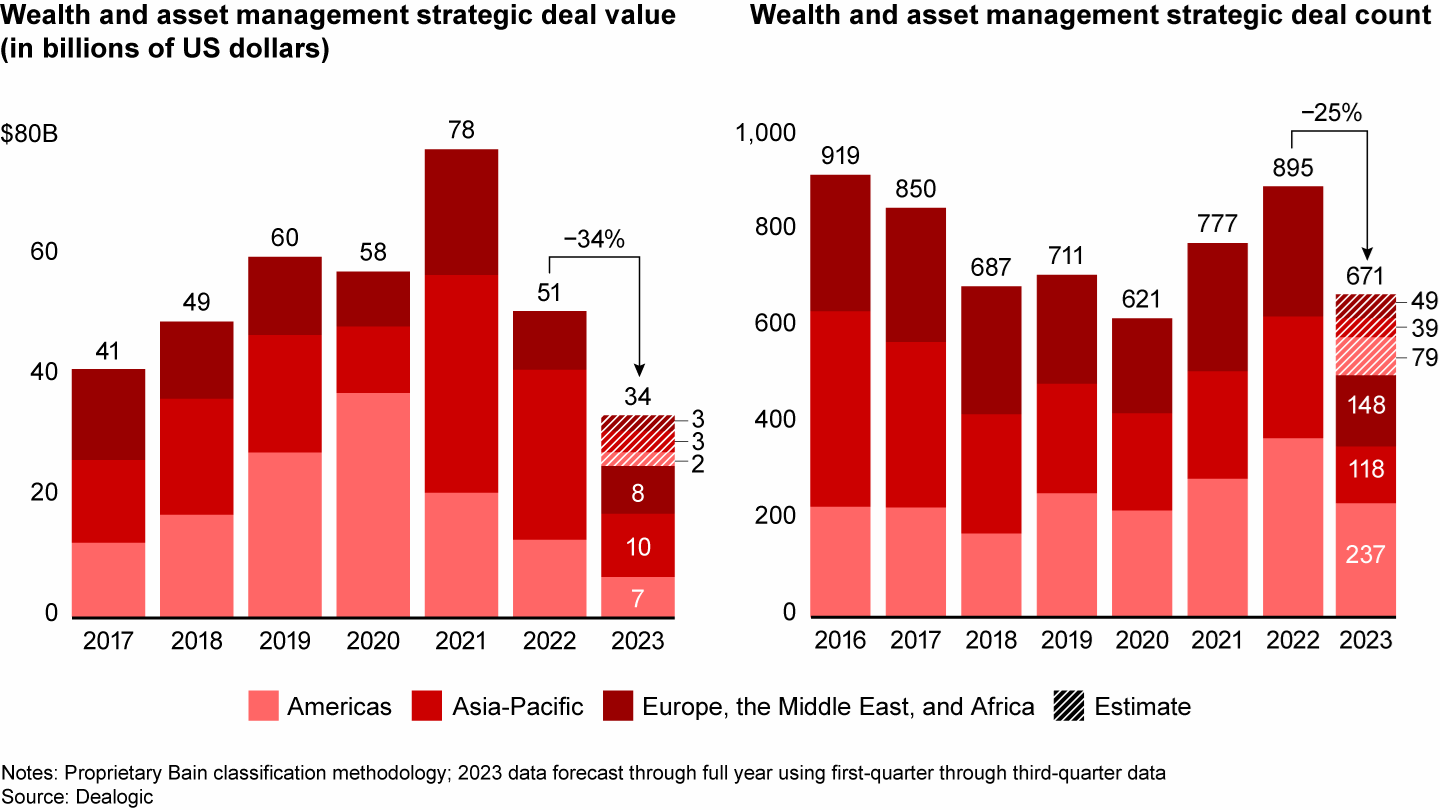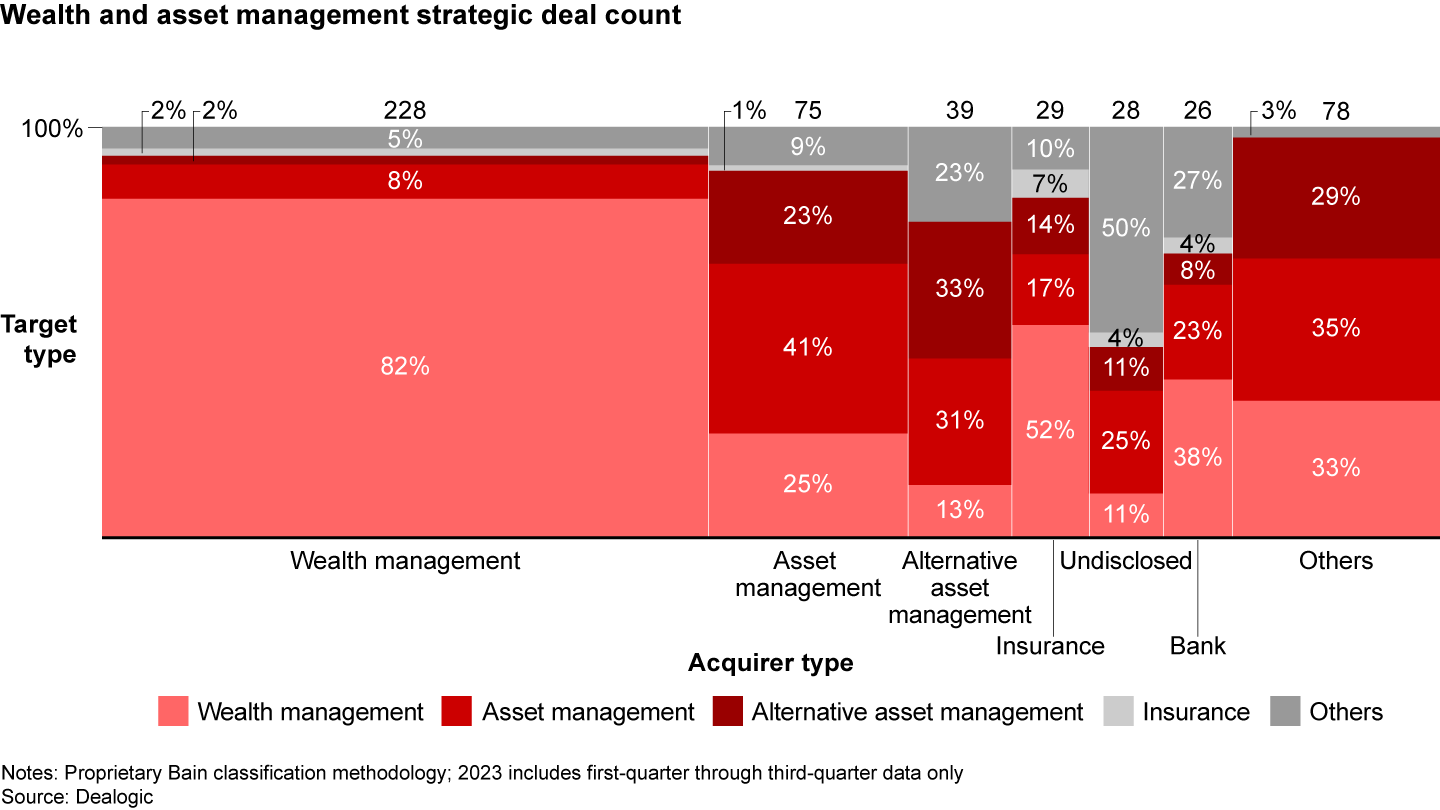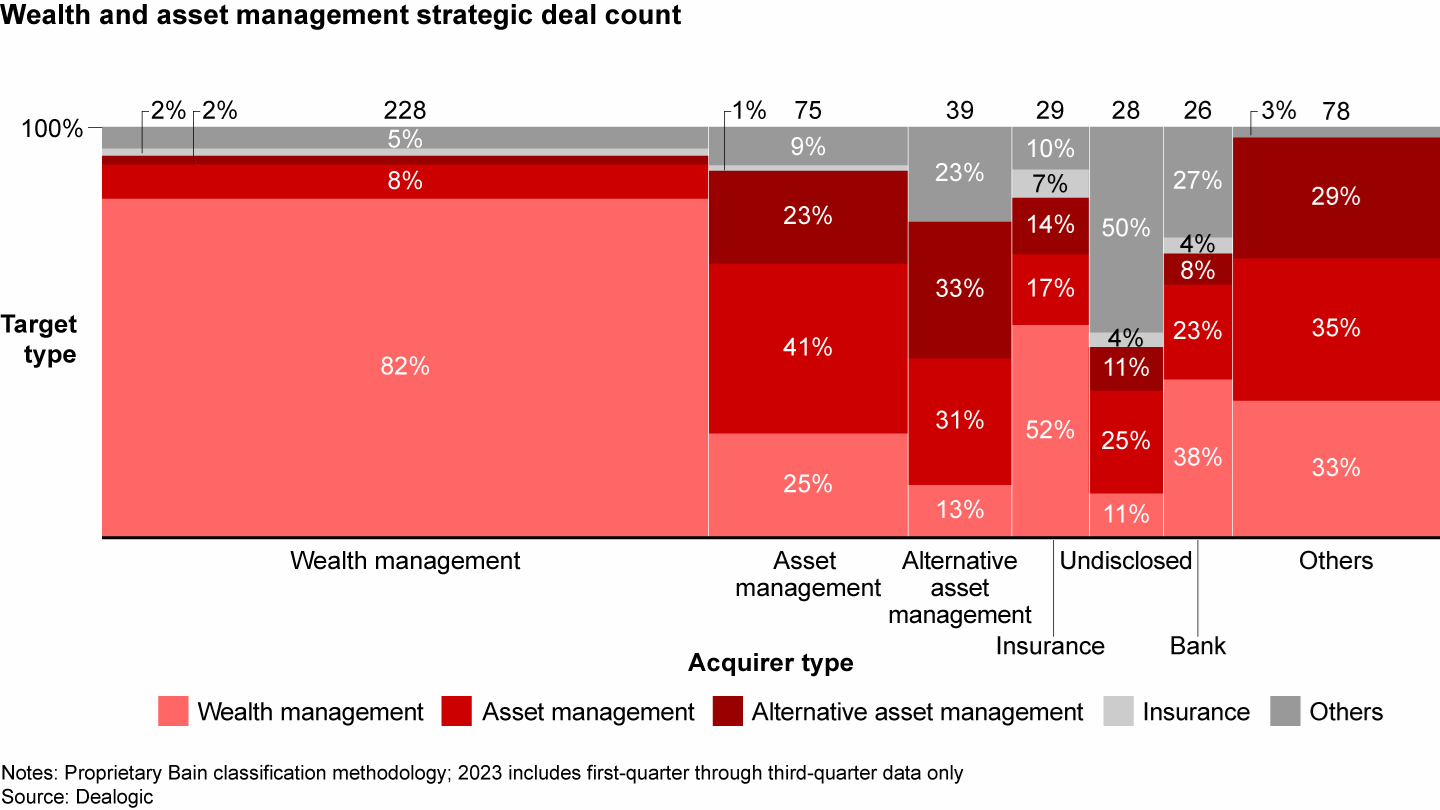M&A Report

At a Glance
- Despite a down year for M&A, wealth and asset managers selectively completed deals to help them consolidate, vertically integrate, broaden their offerings, and expand distribution.
- The benefits of scale in technology and distribution will be especially important for wealth managers, and the benefits of scope will be important for asset managers considering expansion into alternative investments.
- In Asia-Pacific, where deal value dropped the most, companies continued to turn to joint ventures to expand distribution in new markets.
- Consolidation pressures are likely to intensify in 2024, spurring the need for more scale deals while vertical integration will require more scope deals.
This article is part of Bain's 2024 M&A Report.
Globally, in 2023, deal value in the wealth and asset management industry is expected to drop by 34% while volume is expected to sink by 25% (see Figure 1). Despite the lower level of activity, even in a tough environment of uncertainty and high interest rates, companies are finding that they can no longer hold off on deals. But what they do depends on what and where they are. We’re seeing distinctions for wealth vs. asset managers and different dynamics across regions.
Wealth and asset management deal value declined by 34% year over year while deal volume declined by 25%, reflecting smaller average deal sizes


Wealth managers turned to M&A to consolidate. Of the 503 deals taking place during 2023’s first nine months, 188 involved wealth management companies acquiring other wealth management companies in scale deals (see Figure 2).
Globally, most deals were made by wealth managers acquiring other wealth managers


That was the impetus behind Franklin Templeton’s $1.3 billion bid for Putnam Investments and Cetera Holdings’ recent $1.2 billion purchase of Avantax. In other scale deals, universal bank Crédit Agricole’s Indosuez Wealth Management bought a majority stake in private bank pure play Degroof Petercam for slightly more than a $1 billion sum, and UBS acquired rival Credit Suisse, which created a banking and wealth management institution with a $1.6 trillion balance sheet. (Contrary to the global trend, Europe’s deal values are actually projected to be roughly stable in 2023, though deal volumes have decreased. This reflects the fact that there were a larger number of deals in excess of $1 billion.)
Another set of deals involved scope M&A to help companies grow and integrate along the value chain—banks buying asset managers, for example. And there are vertical integration deals that marry asset managers’ products with wealth managers’ distribution. Looming EU-wide regulations—in particular, a potential future ban on retrocessions—have sparked interest in such deals.
US asset managers also opted for scope deals aimed at buying capabilities or distribution.
Meanwhile, customer demand for more sophisticated investment products has led asset managers to pursue scope deals that add capabilities for selling alternative investments such as private market products. That was the objective of MetLife’s purchase of privately owned alternative investment firm Raven Capital Management, for example.
In Asia-Pacific, acquisitions fell the most, dropping 51% in value and 37% in volume. While traditional M&A has slowed down, joint ventures, which are already popular in the region, continued to gain momentum. More than their counterparts in the Americas or Europe, the Middle East, and Africa, Asia-Pacific asset and wealth managers live on the leading edge of technology, with many of the joint ventures aimed at accelerating companies’ advancement in fintech. For example, Avaloq and BlackRock entered a partnership to offer an integrated wealthtech platform to wealth managers not only in Europe but also in Asia-Pacific, addressing a large gap existing with the region’s wealth managers.
Other joint ventures in the region are moves by multinationals intended to extend their distribution reach in fast-growth Asia-Pacific markets, combining a global acquirer’s product strengths with a local player’s distribution networks—a move that helps the acquirer nudge its way into traditionally hard-to-enter onshore markets. It’s a way for international companies to hedge their bets in the region, particularly given the challenging environment for M&A. In India, BlackRock and Jio Financial Services announced a 50-50 joint venture. In China, UBS and ICBC entered an arrangement in which UBS now holds a 20% stake in ICBC Credit Suisse Asset Management, a joint venture that had been partially owned by Credit Suisse. Some companies are now moving past the joint venture stage to gain total control. J.P. Morgan Asset Management acquired full ownership of its China-focused joint venture China International Fund Management, which it established with Shanghai International Trust in 2004.
What’s next? Looking ahead, we expect M&A to rebound as the macroeconomic environment starts to stabilize (albeit at likely higher interest rates) and as sellers recalibrate their expectations and buyers gain more confidence.
We believe that consolidation pressures will intensify further. The underlying business drivers for consolidation remain the same, even in a tough deal environment. The benefits of scale in technology and distribution will be especially important for wealth managers. The benefits of scope will be important for asset managers as they eye expansion into private markets and other alternative investments, or as they seek digital capabilities to serve newly emerging client segments. We also believe that many universal banks looking to define compelling growth strategies will continue to grow their asset-light wealth management or asset management divisions through M&A, particularly in Europe.
Regardless of the objective and region, success will require much more than thoughtful financial engineering. A clear deal thesis and value creation plan will set the winners apart from the laggards. The best companies will rely on an upgraded toolkit for M&A—including deliberate, clearly sequenced strategy, screening, and diligence capabilities, as well as execution and integration capabilities—to be able to successfully execute deals in this high-stakes environment. And they will do it before their competitors. With higher interest rates, companies will need to drive more value beyond financial engineering. This should benefit the strategic buyers, who, unlike their financial acquirer counterparts, are less reliant on low-cost debt.
The macroeconomic headwinds that require companies to strengthen dealmaking economics also make it necessary to strengthen the core business for higher returns. That means actually finishing any integrations they have started and tackling often-ignored technology issues to ensure that they can create value from their deals. In 2024, companies that improve their performance will be those better positioned for deals.